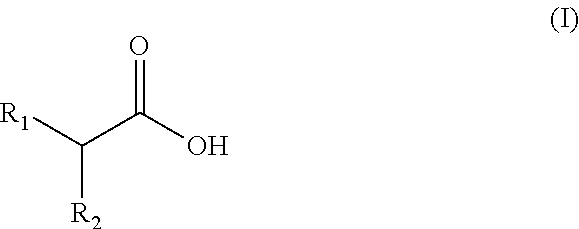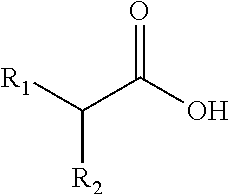Prebiotic Oral Care Compositions Containing Carboxylic Acids
a technology of carboxylic acids and prebiotics, applied in the direction of drug compositions, organic active ingredients, dentistry, etc., to achieve the effect of promoting growth, metabolic activity or colonization, and promoting growth
- Summary
- Abstract
- Description
- Claims
- Application Information
AI Technical Summary
Benefits of technology
Problems solved by technology
Method used
Image
Examples
example 1
[0115]The metabolic activity of various beneficial oral bacteria and pathogenic oral bacteria in the presence of the carboxylic acids succinic acid, L-lactic acid, mono methyl succinate, L-malic acid, citric acid, melibionic acid, alpha-keto-glutaric acid, acetic acid and L-aspartic acid was investigated.
[0116]The beneficial oral bacteria tested were Streptococcus mitis, Streptococcus salivarius, Streptococcus sanguinis, Actinomyces viscosus, Streptococcus gordonii, Capnocytophaga sputigena, Actinomyces naeslundii and Veillonella parvula. The pathogenic oral bacteria tested were Streptococcus mutans, Prevotella intermedia, Porphyromonas gingivalis, Fusobacterium nucleatum, Tannerella forsythia, Aggregatibacter actinomycetemcomitans and Streptococcus sobrinus.
[0117]Substrates that were able to increase the metabolic activity of at least one of the above beneficial bacteria while not or only minimally increasing the growth of the pathogenic bacteria are considered to be prebiotic sub...
example 2
[0125]The extent of growth of various beneficial oral and pathogenic oral bacteria in the presence of the carboxylic acids L-aspartic acid and succinic acid, as examples, was investigated.
[0126]The beneficial oral bacteria tested were Streptococcus mitis, Streptococcus salivarius, Streptococcus sanguinis, Actinomyces viscosus, Streptococcus gordonii, Capnocytophaga sputigena, Actinomyces naeslundii and Veillonella parvula. The pathogenic oral bacteria tested were Streptococcus mutans, Prevotella intermedia, Porphyromonas gingivalis, Fusobacterium nucleatum, Tannerella forsythia, Aggregatibacter actinomycetemcomitans and Streptococcus sobrinus.
[0127]Substrates that were able to increase the growth (or maximal growth density or extent of growth) of at least one of the above beneficial bacteria while not or only minimally increasing the growth (or maximal growth density) of the pathogenic bacteria are considered to be prebiotic compounds.
[0128]The extent of growth of the tested bacter...
example 3
[0133]The effects of the carboxylic acids L-aspartic acid and succinic acid, as examples, upon biofilm growth of various beneficial oral bacteria and pathogenic oral bacteria, was also investigated.
[0134]Substrates that were able to increase the biofilm mass of at least one of the above beneficial bacteria while not or only minimally increasing the biofilm mass of the pathogenic bacteria are considered to be prebiotic compounds.
[0135]The increase in biofilm formation of the tested bacteria in response to selected carboxylic acids (L-aspartic acid and succinic acid) was investigated by setting up biofilm growth assays in a nutritionally rich medium (brain heart infusion broth (BHI), Oxoid), over 48 hours. Late exponential growth phase liquid cultures were prepared by transferring the respective bacterium from blood agar plates to BHI and overnight incubation at 37° C. in an anaerobic atmosphere for A. viscosus, V. parvula, F. nucleatum, P. gingivalis, P. intermedia, T. forsythia, A. ...
PUM
| Property | Measurement | Unit |
|---|---|---|
| mean particle size | aaaaa | aaaaa |
| pH | aaaaa | aaaaa |
| transmittance | aaaaa | aaaaa |
Abstract
Description
Claims
Application Information
 Login to View More
Login to View More - Generate Ideas
- Intellectual Property
- Life Sciences
- Materials
- Tech Scout
- Unparalleled Data Quality
- Higher Quality Content
- 60% Fewer Hallucinations
Browse by: Latest US Patents, China's latest patents, Technical Efficacy Thesaurus, Application Domain, Technology Topic, Popular Technical Reports.
© 2025 PatSnap. All rights reserved.Legal|Privacy policy|Modern Slavery Act Transparency Statement|Sitemap|About US| Contact US: help@patsnap.com



